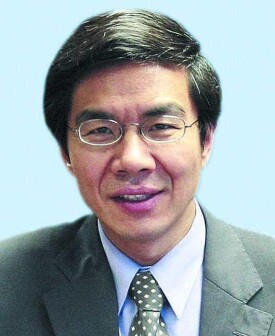唐金陵
香港中文大學醫療學院流行病學教授
唐金陵,北京大學醫學部(原北京醫學院)醫學學士,倫敦大學碩士、博士,牛津大學博士后。現任香港中文大學公共衛生及基層醫療學院流行病學教授、署理院長、流行病學部主任。曾任博士生導師,以及北京大學醫學部13個國家重點學科組成的“十一五”“211工程循證醫學學科群”牽頭人。
獲前國家教委中英友好獎學金公派赴英國攻讀博士學位。
2004年參與創建亞太循證醫學聯盟(Asia Pacific EBM Network,APEBMN),並任該聯盟主席至今;2011年出任亞太公共衛生聯盟(Asia-Pacific Academic Consortium for Public Health,APACPH)副主席;現兼任香港考科藍中心(Hong Kong Cochrane Branch)主任、北京大學循證醫學中心主任;復旦大學循證醫學中心客座教授、英國公共衛生學會資深會員、中華預防醫學會流行病學分會常委、中華預防醫學會健康風險評估與控制專業委員會常委;英國醫學雜誌中文版、中華醫學雜誌英文版、健康管理等雜誌編委;北京大學、復旦大學、中山大學客座教授,中國中醫科學院特聘客座研究員。
主要研究領域涉及循證醫學、醫學決策信息、臨床試驗、系統綜述、中醫藥臨床研究、心血管病初級預防等方面的工作。系統分析並論證了中國心血管病初級預防的整體危險策略;為香港立法會提出“以療效為先導的中醫藥研究與發展綱要”,應邀在“世界經濟論壇”2001年北京商務高峰會做該主題的演講,並為英國醫學雜專輯和柳葉刀雜誌做有關評述;與牛津大學衛生科學院前院長、英國衛生信息總監Muir Gray爵士合著《循證醫療衛生決策》,主譯國際權威醫學證據資源《臨床證據》;與牛津大學循證醫學中心前主任Paul Glasziou教授主編教育部“十一五”規劃教材《循證醫學基礎》,譯Muir Gray爵士的《聰明的病人》。
1. 唐金陵、Paul Glasziou(主編):《循證醫學基礎》,北京大學醫學出版社,2010.[部分章節全文鏈接見參考資料]
2. 唐金陵、王杉(主譯):英國醫學雜誌《臨床證據》中文版,北京大學醫學出版社,2007.
3. 秦穎、唐金陵(譯):《聰明的病人》,北京大學醫學出版社,2006.
4. Muir Gray、唐金陵(合著):《循證醫療衛生決策》,北京大學醫學出版社,2004.
6. 唐金陵。第十六章:臨床流行病學數據的分析與結果解釋。見:李立明主編。臨床流行病學。北京:人民衛生出版社,2011:235-261.[全文鏈接見參考資料]
7. 唐金陵。醫的魔術,醫者的心。健康管理2011;2(5):86-89.[全文鏈接見參考資料]
8. Yang ZY, Mao C, Tang JL. Comments on: Apixaban versus enoxaparin for thromboprophylaxis in medically ill patients. N Engl J Med 2012; 366(8): 767.
9. Mao C, Yang ZY, Hu XF, Chen Q, Tang JL. PIK3CA exon 20 mutations as a potential biomarker for resistance to anti-EGFR monoclonal antibodies in KRAS wild-type metastatic colorectal cancer: a systematic review and meta-analysis. Ann Oncol. 2012; 23(6): 1518-25.
10. Tang JL, Wang S. Defining and providing essential evidence for practice.[確定和提供醫學實踐需要的證據]Clinical Evidence Nov. 17, 2008.[全文鏈接見參考資料]
11. Tang JL. The continuing barriers to research in China.[中國學術研究的障礙]CMAJ 2010; 182(5): 424-5.[全文鏈接見參考資料]
12. TangJL. Evidenced pyramid and new solutions on evidence-based practice.[證據金字塔與循證實踐新思路]Chin JEpidemiol 2011; 32 (12): 1193-98.[全文鏈接見參考資料]
13. Tang JL, Liu JL. Misleading funnel plot for detection of bias in meta-analysis.[檢測Meta分析中的發表偏倚:誤導的漏斗圖]J Clin Epidemiol 2000; 53 (5): 477-84.[全文鏈接見參考資料]
14. Tang JL. Weighting bias in meta-analysis of binary outcomes.[Meta分析中的權重偏倚]J Clin Epidemiol 2000; 53(11): 1130-6.[全文鏈接見參考資料]
15. Tang JL. Selection bias in meta-analyses of gene-disease associations [perspective].[疾病基因研究Meta分析中的選擇偏倚]PLoS Med 2005; 2 (12): e409.[全文鏈接見參考資料]
16. 唐金陵。試論以療效為先導的中醫藥研究策略。英國醫學雜誌(中文版)2006; 04: 222-226.[全文鏈接見參考資料]
17. Tang JL. Research priorities in traditional Chinese medicine.[試論以療效為先導的中醫藥研究策略]BMJ 2006; 333(7564): 391-4.[全文鏈接見參考資料]
18. 唐金陵. 中醫藥及其臨床療效研究。柳葉刀(中文版)2008;01:94-97.[全文鏈接見參考資料]
19. Tang JL, Liu BY, Ma KW. Traditional Chinese medicine.[中醫藥及其臨床療效研究]Lancet 2008;372(9654):1938-40. [全文鏈接見參考資料]
20. Tang JL. Some reflections on the evaluation of clinical effectiveness of Chinese medicine.[關於中醫臨床效果研究的若干思考]Chin J Integr Med 2010; 16(5): 390-1.[全文鏈接見參考資料]
21. Tang JL, Zhan SY, Ernst E. Review of randomized controlled trials of traditional Chinese medicine.[中醫藥隨機對照試驗的方法學質量評價]BMJ 1999;319(7203):160-1.[全文鏈接見參考資料]
22. Wang WZ, Tang JL. Medical screening: to be or not to be?[醫學篩查:做,還是不做?]Chin Med J (Engl) 2010;123(14):1948-51.[全文鏈接見參考資料]
23. Tang JL, Hu YH. Drugs for preventing cardiovascular disease in China.[Editorial][藥物預防心血管病:治療閾值應因資源多寡而定]BMJ 2005;330(7492):610-1.[全文鏈接見參考資料]
24. Tang JL, Armitage J, Lancaster T, et al. A systematic review of dietary intervention trials on cholesterol lowering in free-living individuals.[飲食干預降低血膽固醇效果的系統綜述]BMJ 1998;316(7139):1213-20.[全文鏈接見參考資料]
25. Tang JL, Wang WZ, An JG, et al. How willing are the public to pay for anti-hypertensive drugs for primary prevention of cardiovascular disease: a survey in a Chinese city.[我國居民對降壓藥物治療的支付意願]Int J Epidemiol 2010;39(1):244-54.[全文鏈接見參考資料]
26. Wang WZ, Tang JL, Hu YH, et al. Gap between evidence and physicians’knowledge and practice regarding hypertension and its drug treatment: a survey in a Chinese city.[醫生高血壓及其藥物治療的知識和實踐與證據之間的差距]Chin Med J(Engl)2011;124(8):1235-41.[全文鏈接見參考資料]
27. Tang JL, Dickinson JA, Liu JL. Coronary risk assessment methods and cholesterol lowering. Lancet 1999; 353: 1095-96.
28. Wu HM, Tang JL, Lin XP, Lau J, Leung PC, Woo J, Li YP. Acupuncture for Stroke Rehabilitation. The Cochrane Library, 2007.Tang JL, Morris JK, Wald NJ, et al. Mortality in relation to tar yield of cigarettes: a prospective study of four cohorts.[香煙焦油含量與死亡率關係的前瞻性研究]BMJ 1995;311(7019):530-3.[全文鏈接見參考資料]
29. Law M, Tang JL. An analysis of the effectiveness of interventions intended to help people stop smoking.[戒煙治療措施效果的Meta分析]Arch Intern Med 1995;155(18):1933-41.[全文鏈接見參考資料]
30. Tang JL, Law M, Wald NJ. How effective is nicotine replacement therapy in helping people to stop smoking.[尼古丁替代治療戒煙效果的系統綜述]BMJ 1994;308(6920):21-6.[全文鏈接見參考資料]
31. Lai TC, Tang JL. A systematic review protocol of effectiveness of motivational interview on smoking cessation. The Cochrane Library, 2008.
32. Tang JL, Muir J, et al. Health profiles of current and former smokers and lifelong abstainers. J Roy Coll Phys Lond 1997; 31(3): 304-09.
33. Bista MB, Banerjee MK, Shin SH, Tandam JB, Kim MH, Sohn YM, Ohrr HC, Tang JL, Halstead SB. Efficacy of single-dose SA 14-14-2 vaccine against Japanese encephalitis: a case control study. Lancet 2001; 358: 791-5.
34. Yuan JQ, Zhang RJ, Yang ZY, Lee J, Liu YL,Tian JH, Qin XW, Ren ZJ, Ding H, Chen Q, Mao C and Tang JL. ComparativeEffectiveness and Safety of Oral Phosphodiesterase Type 5 Inhibitors forErectile Dysfunction: A Systematic Review and Network Meta-analysis. Eur Urol.2013 Jan 31.(In press)[全文鏈接見參考資料]
35. Liu JL, Tang JL. Assessing prevention interventions by "number needed to treat" JAMA 2000; 284: 303-4.
